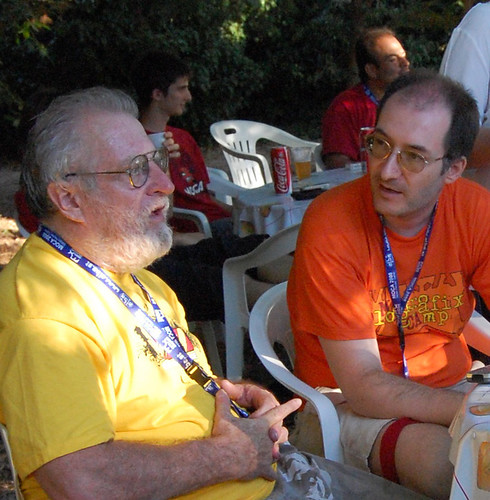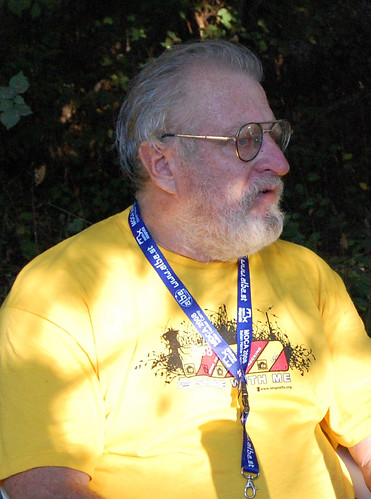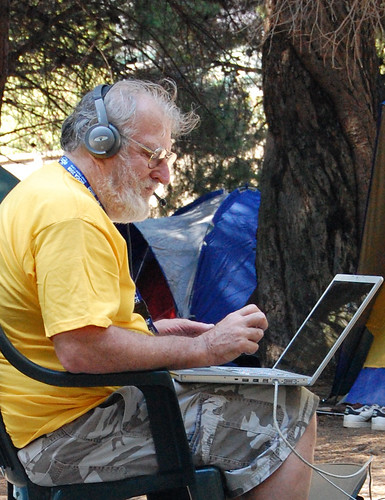Nota: l’intervista è disponibile anche in una versione tradotta in italiano su Storie di Apple.it
At the MOCA2008 “hacker camp” in Italy I had the pleasure to meet and speak with John T. Draper. Draper is better known as Captain Crunch a man whose work and life are deeply intertwined with the history of hacking, phreaking and the personal computer industry.
Here’s the transcription of the short chat we had, which verged mostly on his interactions with Apple, Steve Wozniak and Steve Jobs and also his use of Macs.
 Stories of Apple: What’s the story behind you doing the Apple II phone board?
Stories of Apple: What’s the story behind you doing the Apple II phone board?
John Draper: Let’s start talking a bit about how I met Steve Wozniak. […] He contacted me when I was a DJ at KKUP radio. He asked whether or not I could come down and see his bluebox. He wanted me to show him how to use it. I was very suspicious of him. It was at a time during which there was a lot of busts going on and I thought this might have been a setup.
So I made my arrangements to go see him without having anything on me and illegal things not being there. When I saw him he showed me the bluebox: I was not impressed.
The problem with this bluebox was that it had a square wave instead of a sine wave: the tones are not pure, They sound crappy and anybody using one of those Woz’s blueboxes would often drop a trouble card in the switch because the switch wouldn’t recognize tones and wouldn’t accept them.
[…] As my relationship with him grew […] he introduced me to Steve Jobs. Jobs was working on a little 6 bit computer. And he said “Whoa, why only 6 bits?” Six bits can only give you a number of the count to only 32 and he said “just to demonstrate that I can do a computer, that’s all” I said “That’s cool”. Then two or three years later when Woz was developing the Apple I and then of course later on the Apple II he was using a cross-assembler that I wrote because during that time all these microprocessors where coming on the market people needed to build the right assembler language to write their software.
SoA: Which microprocesors?
JD: We did it for the [Intel] 8080, the Z80, 6502, 1802 and the 6800.
SoA: Were you working alone at the time or did you have any…
JD: I developed the cross-assemblers on a time-sharing system that only ran Basic. It would take the assembler code, parse into opcode […] and it would then output it in binhex so you could take it and dump it into your tape.
SoA: Not a print-out?
JD: No, you could get tape readers back then for about fifteen bucks: they were surplus. That was how probably Bill Gates put in Microsoft Word at Microsoft. Once that got in he then developed more, a more robust development system, called the Crust development system. […]
After that Wozniak […] was working on the Apple II and he offered me a job and my job was to design and develop a “charlie board”.
 SoA: as an employee or an outside contractor?
SoA: as an employee or an outside contractor?
JD: Yeah, as an outside contractor job. So I built the board: it had nine chips. Woz says “Nine! Chips!” He said: “No, shit, too much!” and he said “I’ve got a better design for you and he gives me a design with five chips so I’ve tried to build that [laughter] but I said “wait a minute, you are only using a 6 bit deck instead of a 8 bit deck” and he said “Yeah, 8 bit decks cost too much: I can build a 6 bit and I can write the software so you don’t have to buy that chip”
So I worked on how to get the extra two bits from. Guess? The address line. The extra two bits I grabbed from the address line. […] I was just peeking and poking the address. That was my phone board.
SoA: Was it ever sold? Did they actually make it available?
JD: No. AT&T made sure of that. They were too freaked out. Because everything was done in software the board could have evil thoughts and you don’t wanna have a board with evil thoughts. […] There was software and with the right tone table you could turn it into a bluebox. AT&T did not want that. […] They put pressure on Jobs. Not Woz, on Jobs to say “Wow! AT&T says ‘you put this out and we’ll sue you’ “.
There were also other problems. The board, to work, had to directly connect to the phone line. At the time this came out, which was in 1975 […] actually more like 1976 in order for you to connect to a phone line you had to have a PacBell-approved connection interface device […] and the cheapest one was 450 bucks. Therefore in order to use it as a telephone board a person had also to pay that 450 bucks to buy one of those devices while it was feasible to do all of that work just connecting to the telephone. Well, they kept a lot of pressure on Jobs […] “We’re gonna sue you!”. They can’t let people connect shit to their telephone lines, right?
SoA: And then…
JD: Then came the modem. […] The DC Hayes modem. They came out with a 1200 baud modem. It connected to their phone line because in a while they relaxed their restrictions so you could connect to the phone line
SoA: And they were approved.
JD: And they were approved.
The basic problem I had was saturation to the transformer. The phone line said that DC current ran through the transformer. If pure DC current ran through the transformer it would saturate […]. When you saturate a transformer you get distortion. It’s like when you have video and you turn video all the way […]. You lose the quality, it’s very distorted, not good.
SoA: How fast would have been the board?
JD: Around 300 baud but we used to say “programmable” phase shift. […] A programmable phase-locked loop [which] allows you to pick up a frequency and lock on that frequency. […] If that frequency starts coming down the line you can then detect it […] by the phase-locked loop: it would turn around to that frequency. The modem had a switch between two frequencies, I had a phase-locked loop. Did it all in software.
SoA: Was it very common to use few chips and do it all in software?
JD: Well, that was sort of Woz’s philosophy. Me I didn’t care how many chips I used as long as I got them working. Wozniak was thinking more in terms of economics.
SoA: Probably behind that there was actually Jobs.
JD: Yeah, exactly. Exactly. Jobs was very very much influenced by Woz, by Woz’s need to have things done cheaply. It was something that Woz sort of, you know… ’cause Jobs manipulated Woz. […] Jobs is a very manipulative person. […] Nowadays if you walk in an elevator and Jobs goes in there, by the time the elevator gets to your floor and you get out you’re gonna get fired. He’s very very ruthless.
SoA: They say he asks “what are you doing for me?”
JD: Exactly. He says “what are you doing for me?” Exactly. And if you don’t give him the right answer you’re outta work […]. Not good. Not a good person to work for.
SoA: Did you have any chance to meet Jobs lately.
JD: I ran into Jobs when I was at Apple Computer down at the testing labs testing some of my software.
SoA: How long ago?
JD: I suppose it was in 2004, 2005. And I was working on a VoIP a Voice Over IP […] application for a private company.
 SoA: After the board thing fell through you developed the word processor software, right?
SoA: After the board thing fell through you developed the word processor software, right?
JD: That was later […] actually two years later. I started in 1979: I built EasyWriter in 1979. Barney Stone was coming out with an application program written in Basic. I showed him Easy Writer […] He wrote in Integer Basic. A word processor.
SoA: Did you also write it in Basic?
JD: No, I wrote it in Forth. And all the scrolling I did that in assembly language […] it was very fast. We adapted it with a VMI, Virtual Machine Interface. Today, that language would be called a driver, video driver, a virtual machine interface. We developed it for the VIDEX board.
SoA: What was that?
JD: Videx was an 80 column board for the Apple II. Then we did the IBM PC. All we had to do was adapt to the IBM PC video […]
SoA: You then switched over to the IBM PCs which probably were a more profitable market…
JD: Well, you know, when the PCs came out there weren’t that many of them, there were many more Apples.
SoA: So, what have you been doing lately?
JD: I work for a company called En2go: we are an entertainment company, we do media. We are a media delivery company. We deliver video to your desktop. Media […] movies, entertainment, games, music… whatever, 3D animations. […] I am their CTO (Chief Technical Officer) and I’m in charge of five different teams with each team working on a specific part of the company.
SoA: Is it just software or also hardware?
JD: It’s software and also hardware. Actually mostly software right now [but] we have a set-top box, we call it the Flixo. It’s a video delivery system to your Macintosh, delivers media to your desktop.
SoA: Only for the Macintosh?
JD: I believe we’re working on a PC version but it’s not as mature […].
[Note: the Flixo program streams high definition-quality video to home computers, allowing the monitor to function like an HD television.]
 SoA: So, I’ve seen you using a Mac. […] Why?
SoA: So, I’ve seen you using a Mac. […] Why?
JD: Because we like the interface and using [Mac] OS X. We’re developing using Cocoa, the programming environment Xcode. Cocoa is an Objective C…
SoA: ..and is it easier to write with?
JD: Yeah, it’s wired up, man. Fuckin’ wired up man. […] It was borrowed from NeXT. Jobs owned all the code from NeXT, he brought it into Apple. It’s part of Xcode, part of Cocoa.
SoA: Did you have any prior experience with the NeXT Step system?
JD: Yeah, of course. I used it when it came out, I know Cocoa from back then. You know what NS stands for? […] The names of the functions start with NS. […] For the Windows version we use… how is it called… Visual C++.
SoA: Do you have any personal projects? Working on some hardware, on some board?
JD: Personal projects… oh yeah, I’m doing Crunch TV: it’s a TV program on one of our Flixo channels. It’s on CrunchTV.net right now, they have a first episode right now, you can watch it anytime you want.
SoA: Is it going to be a monthly show? Or weekly?
JD: It hasn’t been set on yet. […] Eventually, we’re gonna move our studio from Las Vegas to Hollywood. […] We have got lots and lots of raw video footage: we haven’t got to date a video editing suite that we like. And I don’t wanna do it. I hate video editing, I think somebody else will do that.
Thanks to Metro Olografix for inviting Mr. Draper, to Massimo “manray” Politi for the heads up and pictures during the chat and Salty Dog for helping figuring out some (I hope most) of the technical terms mentioned.

OS11
Thanks for keeping us up to date with Captain Crunch! Great stuff!
ShangoRasta
I got into computer programming because of this guy, a big hero of mine.
Will Bartlett
I’m having trouble logging on to crunchtv.net